Firefighting is a noble profession marked by bravery and sacrifice. When a firefighter falls, the community comes together to honor their heroism through deeply rooted traditions and ceremonies. Planning a firefighter funeral is both a solemn duty and a significant event, reflecting the profound respect and gratitude held for these public servants. This comprehensive guide delves into firefighter funerals' customs, planning processes, and unique elements, providing valuable insights for families, colleagues, and community members.
From the haunting melodies of bagpipes to the ceremonial folding of the flag, each aspect of a firefighter's funeral is designed to pay tribute to the life and service of the fallen. We will explore the meticulous planning, the emotional and logistical support provided to grieving families, and the significance of traditional customs such as the Last Call and the Fireman’s Prayer. Additionally, we will discuss the growing trend of celebrations of life, offering a more personalized and uplifting alternative to traditional funerals.
By understanding these elements, we can ensure that firefighters' bravery and sacrifice are honored with the dignity and respect they deserve. Join us as we navigate through the profound and moving practices that commemorate the lives of these everyday heroes.
Planning a Firefighter Funeral
Planning a firefighter's funeral involves several steps to honor the fallen hero while respecting the family's wishes. The process begins with careful consultation and coordination between the fire department and the deceased's family, ensuring a ceremony that appropriately reflects the firefighter’s service and the family’s preferences.
Initial Steps: The first step in planning a firefighter's funeral is to consider the firefighter’s final wishes if known. Many fire departments proactively ask their members to document their funeral preferences, including choices for music, pallbearers, clergy, and interment details. This forethought helps streamline the planning process during a time of grief.
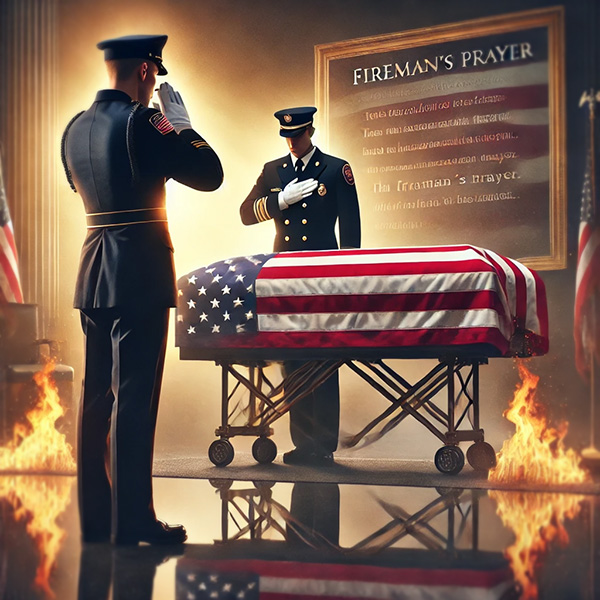
Once the firefighter’s directives are considered, the family's wishes take precedence. The fire department assigns a family liaison officer as a single point of contact, helping the family navigate the various options and traditions available. This liaison ensures the family is not overwhelmed and their decisions are respected throughout the planning.
Roles and Responsibilities: Various roles within the fire department are crucial for organizing a firefighter’s funeral. A family liaison officer provides emotional support and coordinates between the family and the department. The funeral officer handles logistics, such as securing the venue and coordinating with funeral homes. Additionally, a cemetery officer manages burial or inurnment arrangements. Larger fire departments might also have a Survivor Action Officer who oversees a team that supports the family.
Family Involvement: It is essential that the family feels involved and supported throughout the planning process. The fire department offers several traditional elements, but the family decides which customs to include. They might choose whether to have an honor guard, select pallbearers, decide on using fire apparatus in the procession, and choose the music played during the ceremony.
Families are also asked specific questions to tailor the funeral to their needs. These include decisions about having a church service, the location of the funeral, who will deliver the eulogy, and the type of ceremony (formal, semi-formal, informal, or private). The fire department respects these choices, ensuring a personalized and meaningful service.
Logistical Considerations: Logistics play a critical role in firefighter funerals, especially when anticipating a large turnout from the firefighting community and the public. The fire department often helps arrange accommodations for out-of-town guests by coordinating with local hotels to secure blocks of rooms at discounted rates. They also work with local police to plan the funeral procession route, ensuring a smooth and respectful journey from the service location to the burial site.
Emotional and Community Support: Support extends beyond logistics. The fire department provides grief counseling and other emotional support services to the family, recognizing the profound impact of their loss. Community involvement is encouraged, with colleagues and neighbors coming together to offer condolences and practical support.
Planning a firefighter funeral is a comprehensive process that involves meticulous coordination and deep respect for the family’s wishes. By balancing traditional honors with personalized touches, the fire department ensures a ceremony that dignifies the firefighter’s service and supports the grieving family. This collaborative approach helps the family navigate this challenging time, giving them solace and honor their loved one deserves.
Traditional Customs and Honors
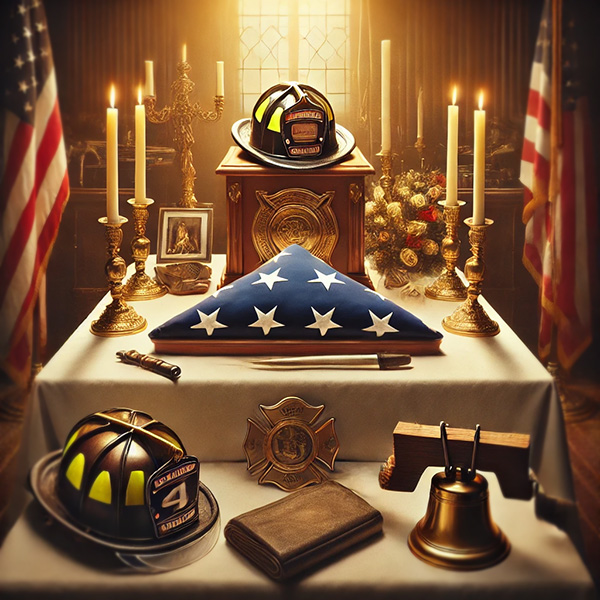
Firefighter funerals are rich in traditions that honor the bravery and service of fallen heroes. These customs and honors not only mark respect but also provide solace to grieving families and fellow firefighters. Here, we delve into some of the most significant traditions that characterize firefighter funerals.
Bagpipes and Music: One of the most iconic elements of firefighter funerals is playing bagpipes. The tradition of bagpipes dates back to the funerals of Scottish and Irish immigrants who became firefighters in the United States. The sad, haunting sound of the bagpipes, often playing "Amazing Grace," is a poignant tribute to the fallen. This tradition has since been adopted widely, symbolizing the courage and sacrifice of firefighters. Other popular songs at firefighter funerals include "Danny Boy," which Elvis said he thought “Danny Boy” was written by angels and asked for it to be played at his funeral. Similarly, though the words differed, Princess Diana's church service included the same haunting melody.
Helmet on the Altar: During the service, the firefighter's helmet is placed on the altar or the casket. This simple yet powerful gesture symbolizes the firefighter's role and readiness to serve even in death. It serves as a poignant reminder of the sacrifice made by the firefighter and is a deeply respected custom in these ceremonies.
Folded Flag: Another key tradition is draping the firefighter’s casket with the American flag, which is later ceremonially folded and presented to the next of kin. This practice is akin to military funerals, underscoring the parallel between the bravery of soldiers and firefighters. The flag presentation is a moving tribute, recognizing the firefighter's service to their community and country .
Bell Ceremony and Last Call: The "Last Alarm" or "Last Call" is a deeply moving part of firefighter funerals. During this ceremony, a bell is rung three times, a tradition that historically signaled the end of a fire call. Today, it symbolizes the end of the firefighter’s duties. Concurrently, a dispatcher calls out the fallen firefighter’s name over the radio one last time, marking their final call to duty. This solemn moment brings closure and honors the firefighter’s service and sacrifice.
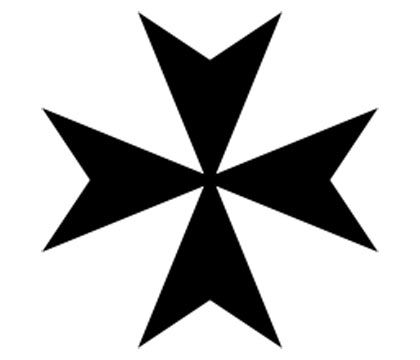
Maltese Cross: The Maltese Cross symbolizes protection and a badge of honor in the firefighting community. At funerals, it is often incorporated into various elements such as flower sprays covering a casket, pins, or displayed prominently. This emblem represents the firefighter's bravery and willingness to risk their life for others, a central tenet of the firefighting profession.
Procession and Honor Guards: The funeral procession is another significant tradition, often involving a motorcade led by fire engines, including a fire engine caisson carrying the casket. This visual represents the firefighter’s last ride, surrounded by their comrades. An honor guard, composed of fellow firefighters in full dress uniform, stands watch and serves as pallbearers. This solemn duty reflects the respect and camaraderie within the firefighting community.
Community and Departmental Involvement: Firefighter funerals often see extensive involvement from the fire department and the wider community. Fellow firefighters participate actively, from serving in the honor guard to assisting with logistical arrangements. Community members also show their support, often lining the procession route and attending the services to pay their respects. This collective involvement highlights the deep bond between firefighters and the communities they serve.
The traditions and honors observed in firefighter funerals are profound expressions of respect and gratitude. They honor the fallen heroes and provide comfort and support to the bereaved families and fellow firefighters. These customs ensure that firefighters' bravery and sacrifice are remembered and celebrated with the dignity they deserve.
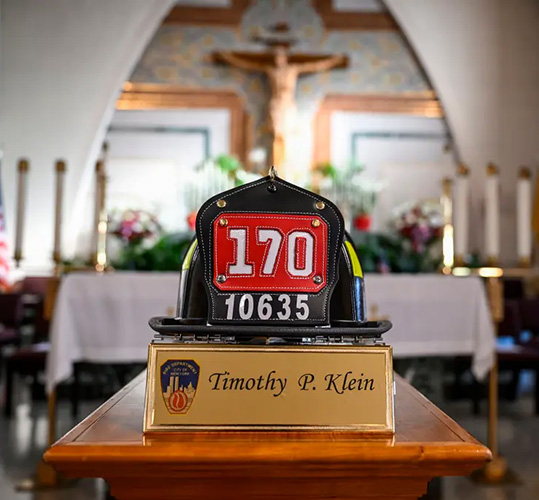
Order of Funeral Service
The order of service at firefighter funerals is a meticulously planned sequence of events designed to honor the fallen hero and provide a structured environment for mourning and reflection. This order can vary based on the firefighter's personal and family preferences, religious beliefs, and departmental traditions, but it typically follows a respected and solemn format.
Procession and Arrival: The funeral service often begins with a formal procession. This includes fire engines and apparatus, sometimes with a fire engine caisson carrying the casket. The procession is a powerful visual tribute, symbolizing the firefighter’s last ride. Fellow firefighters, dressed in formal uniforms, may march alongside the vehicles, displaying unity and respect.
Opening and Welcome: Upon arrival at the service location, whether a funeral home, church, or another venue, the service usually begins with an opening statement or prayer. This part of the ceremony sets a solemn tone and comforts the grieving family and friends. It is often led by a clergy member, chaplain, or a designated speaker from the fire department.
Eulogies and Tributes: Eulogies are a central service component delivered by family members, close friends, and colleagues. These speeches reflect on the firefighter's life, character, and contributions. The fire chief or a senior officer often delivers a formal tribute, highlighting the firefighter’s service record and bravery. Personal anecdotes and memories help celebrate the life and legacy of the fallen.
Musical Interludes: Music plays a significant role throughout the service. Traditional songs such as "Amazing Grace" played on bagpipes, "Danny Boy," and other chosen hymns or favorite songs of the deceased are often included. These musical pieces provide emotional resonance and connect deeply with the attendees.
Ceremonial Honors: Several ceremonial honors are performed during the service. These include the presentation of the firefighter’s helmet and the ceremonial folding and presentation of the flag to the next of kin. Standing watch over the casket, the honor guard adds to the occasion's solemnity. The bell ceremony, known as the "Last Alarm," involves ringing a bell three times, symbolizing the end of the firefighter’s final call.
The Fireman’s Prayer: The Fireman’s Prayer is poignant, heartfelt, and often included in firefighter funerals. It was written by A.W. "Smokey" Linn, a fireman from Wichita, Kansas, and first published in 1958. The prayer eloquently expresses firefighters' dedication, bravery, and selflessness, asking for strength and protection in the line of duty. It has become a cherished part of firefighter traditions, providing comfort and inspiration to firefighters and their families during these solemn ceremonies.
Procession to the Burial Site: Following the service, the procession moves to the burial site. This part of the ceremony often includes a motorcade of fire engines and other vehicles, with firefighters marching in step. The route may pass significant locations, such as the firefighter’s station, allowing colleagues and community members to pay their respects.
Committal Service: A brief committal service occurs at the burial site. This includes final prayers, the lowering of the casket, and additional ceremonial honors such as the presentation of the flag. The service concludes with a final salute from fellow firefighters, marking the end of the formal proceedings and providing a final tribute to the fallen hero.
The order of service at firefighter funerals is a comprehensive and respectful sequence of events that honors the deceased and supports the grieving family. It combines solemnity with tradition, ensuring that the bravery and sacrifice of the firefighter are fittingly remembered and celebrated.
Music at Firefighter Funerals
Music is central to firefighter funerals, providing an emotional and symbolic backdrop to the ceremonies. The selection of music is often a blend of tradition and personal preference, aiming to honor the fallen firefighter's legacy while offering comfort to the bereaved. Here, we explore common songs and the origins of using bagpipe music in these solemn events.
Common Songs at Firefighter Funerals: One of the most universally recognized songs played at firefighter funerals is "Amazing Grace." This hymn, often performed on bagpipes, has become synonymous with mourning and remembrance. Its haunting melody and poignant lyrics offer solace and reflect the gravity of the loss. "Danny Boy," another popular choice, resonates with its farewell and eternal peace themes. Both songs move deeply and hold significant emotional weight during the service.
Other songs frequently heard at firefighter funerals include "The Firefighter’s Prayer," which pays tribute to firefighters' bravery and dedication. This song, often set to a somber melody, echoes the sentiments of sacrifice and service. Additionally, hymns like "Ave Maria" and "The Lord's My Shepherd" are commonly selected for their spiritual and comforting tones. These choices help to create a respectful and reflective atmosphere, honoring the deceased's faith and service.
Why Are Bagpipes Played at Firefighter Funerals?: The tradition of using bagpipes at firefighter funerals dates back to the 19th century, with its roots in the funerals of Scottish and Irish immigrants who served as firefighters in the United States. Bagpipes were a staple in the mourning customs of these communities, symbolizing a connection to their heritage and the occasion's solemnity. Over time, this tradition was embraced more broadly within the fire service, transcending cultural origins to become a universal symbol of honor and respect.
The distinct and melancholy sound of the bagpipes is particularly suited to the gravity of a funeral. Songs like "Amazing Grace" played on bagpipes evoke a powerful emotional response, providing a fitting tribute to the courage and sacrifice of firefighters. The bagpipe’s association with mourning and remembrance makes it an integral part of firefighter funerals, adding a unique and historical touch to the ceremony.
Incorporating Personal Preferences: While traditional music holds a significant place in firefighter funerals, the deceased's or their family's personal preferences are also crucial. Families might choose songs that held special meaning to the firefighter, incorporating contemporary music or specific genres that reflect the individual's life and passions. This personalization ensures that the service not only honors the professional life of the firefighter but also celebrates their personal identity and relationships.
Music at firefighter funerals is a powerful element that combines tradition, personal reflection, and emotional resonance. Songs like "Amazing Grace" and the historical presence of bagpipes create a solemn and respectful atmosphere while allowing room for personal touches, ensuring a meaningful and personalized farewell. These musical choices help to honor the fallen hero and comfort those left behind, encapsulating the spirit of remembrance and celebration of life.
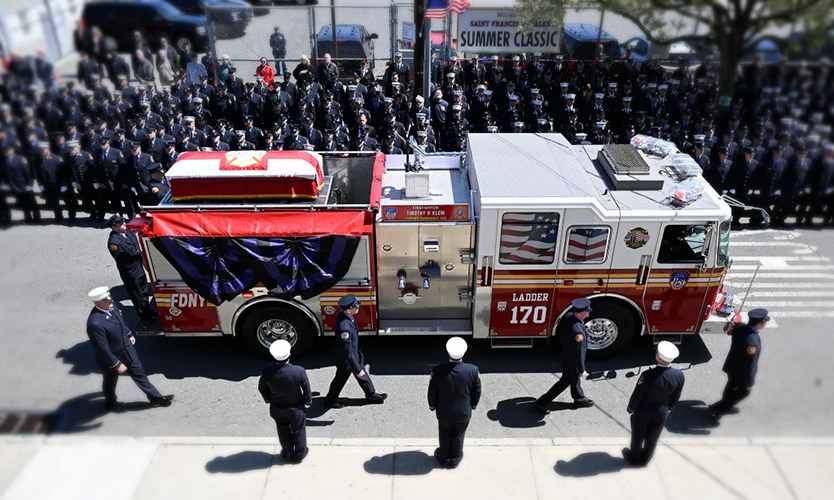
9/11 Funeral Celebrations
The tragic events of September 11, 2001, profoundly impacted the world, and the heroism of the firefighters who responded to the crisis has been etched into collective memory. The funerals and memorials for the 343 firefighters who lost their lives that day were marked by an unparalleled outpouring of grief and respect, reflecting the magnitude of their sacrifice.
Honoring the Fallen: In the aftermath of 9/11, firefighter funerals took on national significance. The ceremonies were not only attended by family and local fire department members but also by dignitaries, fellow firefighters from across the country, and international representatives. These services were often held in large venues to accommodate the vast number of mourners, and many were broadcast on national television, allowing the entire nation to partake in the mourning and honoring of these heroes.
Traditional Customs: The funerals incorporated traditional firefighter customs on a grand scale. Bagpipes playing "Amazing Grace" echoed through the streets of New York City, and the ceremonial ringing of the bell signaled the final call for each fallen firefighter. The Fireman’s Prayer, written by A.W. "Smokey" Linn, was recited, underscoring the dedication and courage of those who served. The Maltese Cross, symbolizing protection and sacrifice, was prominently displayed, emphasizing the valor of the firefighters who laid down their lives.
Community and National Support: The community and national support were overwhelming. Streets were lined with people paying their respects, and makeshift memorials with flowers, photos, and gratitude messages sprung across the city. The fire departments from various states sent representatives, and many provided logistical support for the services, exemplifying the solidarity and brotherhood within the firefighting community).
Legacy and Remembrance: The legacy of the 9/11 firefighters continues to be honored through annual memorials and events. The National September 11 Memorial & Museum in New York City serves as a lasting tribute, featuring the names of all the fallen firefighters. Their heroism is remembered and celebrated yearly, ensuring their sacrifices are never forgotten.
9/11 firefighter funeral celebrations were monumental events that honored the bravery and sacrifice of those who responded to one of the darkest days in American history. These heroes are continuously celebrated and remembered through traditional customs, national participation, and ongoing remembrance.
Celebrations of life offer a personalized and uplifting way to honor a firefighter’s legacy. By focusing on the deceased's positive impact and cherished memories, these events provide a meaningful and supportive environment for families and communities to come together and celebrate the lives of their loved ones. This approach ensures that the firefighter’s service and personal achievements are remembered with joy and gratitude.
Honoring fallen firefighters through well-planned funerals and memorials is a testament to their bravery and service. Rich in tradition and respect, these ceremonies provide solace to grieving families and communities. By understanding the various elements involved, from the order of service to the role of music, we can ensure that the sacrifice of these heroes is appropriately commemorated. Whether through traditional funerals or personalized celebrations of life, each tribute celebrates the legacy of those who have dedicated their lives to protecting others.
When planning a firefighter funeral, selecting the right casket is a crucial step in honoring your loved one with dignity. Avoid the high markups and pressure often associated with funeral homes by visiting www.overnightcaskets.com. They offer a wide selection of high-quality funeral caskets, ensuring you can choose a fitting tribute without the stress and financial burden. Explore their offerings today to find the perfect casket that honors the bravery and service of your fallen hero.

